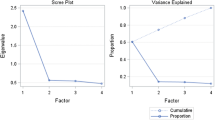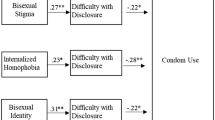Abstract
Cisgender men partnered with transgender women are an understudied and hard to engage population in HIV prevention efforts. Relationship stigma—the anticipation of negative treatment based on having a relationship with a member of a stigmatized group—has been linked to adverse health behaviors, but it remains unclear whether different sources of relationship stigma (i.e., family, friends, and the general public) are associated with HIV risk behaviors and whether these associations may vary by men’s sexual identities (e.g., gay, bisexual, and heterosexual). The current study examined associations between relationship stigma and HIV risk behaviors and whether these associations were moderated by sexual identity. We recruited a convenience sample of 185 cisgender men in primary partnerships with transgender women to participate in a one-time survey. Gay identified men reported greater levels of relationship stigma from the general public compared with heterosexually identified men. In multivariable models, higher levels of relationship stigma from the public were associated with increased odds of engaging in drug use prior to having condomless sex and receiving an STI diagnosis in the last 30 days. There were significant interaction effects such that higher levels of relationship stigma from the public were associated with both indicators of HIV risk for gay identified men but not for heterosexually identified men. Findings support the importance of HIV prevention approaches accounting for relationship stigma from the general public and the diverse sexual identities of men partnered with transgender women when seeking to increase linkage to and engagement in HIV prevention services, including biomedical prevention strategies.


Similar content being viewed by others
References
Aiken, L. S., & West, S. G. (1991). Multiple regression: Testing and interpreting interactions. Newbury Park, CA: Sage.
Baral, S. D., Poteat, T., Stromdahl, S., Wirtz, A. L., Guadamuz, T. E., & Beyrer, C. (2013). Worldwide burden of HIV in transgender women: A systematic review and meta-analysis. Lancet Infectious Diseases,13(3), 214–222.
Boone, M. R., Cook, S. H., & Wilson, P. (2013). Substance use and sexual risk behavior in HIV-positive men who have sex with men: An episode-level analysis. AIDS and Behavior,17(5), 1883–1887.
Bradford, J., Reisner, S. L., Honnold, J. A., & Xavier, J. (2013). Experiences of transgender-related discrimination and implications for health: Results from the Virginia Transgender Health Initiative Study. American Journal of Public Health,103(10), 1820–1829.
Closson, E. F., Mitty, J. A., Malone, J., Mayer, K. H., & Mimiaga, M. J. (2016). Exploring strategies for PrEP adherence and dosing preferences in the context of sexualized recreational drug use among MSM: A qualitative study. AIDS Care,30(2), 191–198.
Feinstein, B. A., Moran, K. O., Newcomb, M. E., & Mustanski, B. (2019). Differences in HIV risk behaviors between self-identified gay and bisexual young men who are HIV-negative. Archives of Sexual Behavior, 48(1), 261–275.
Gamarel, K. E., Chakravarty, D., Neilands, T. B., Hoff, C. C., Lykens, J., & Darbes, L. A. (2019a). Composite risk for HIV: A new approach towards integrating biomedical and behavioral strategies in couples-based HIV prevention research. AIDS and Behavior, 23, 283–288.
Gamarel, K. E., Reisner, S. L., Darbes, L. A., Hoff, C. C., Chakravarty, D., Nemoto, T., & Operario, D. (2015). Dyadic dynamics of HIV risk among transgender women and their primary male partners: The role of sexual agreement types and motivations. AIDS Care,28(1), 104–111.
Gamarel, K. E., Reisner, S. L., Laurenceau, J.-P., Nemoto, T., & Operario, D. (2014). Gender minority stress, mental health, and relationship quality: A dyadic investigator of transgender women and their cisgender male partners. Journal of Family Psychology,28(4), 437–447.
Gamarel, K. E., Sevelius, J. M., Reisner, S. L., Sutten Coats, C., Nemoto, T., & Operario, D. (2019b). Commitment, interpersonal stigma, and mental health in romantic relationships between transgender women and their cisgender male partners. Journal of Social and Personal Relationships, 36, 2180–2201.
Hendricks, M. L., & Testa, R. J. (2012). A conceptual framework for clinical work with transgender and gender nonconforming clients: An adaptation of the minority stress model. Professional Psychology: Research Practice,43(5), 460–467.
Kalichman, S. C., Kalichman, M. O., Cherry, C., Hoyt, G., Washington, C., Grebler, T., … Welles, B. (2015). Intentional medication non-adherence due to interactive toxicity beliefs among HIV-positive active drug users. Journal of Acquired Immune Deficiency Syndromes,70(5), 503–509.
Kapilashrami, A., & Hankivsky, O. (2018). Intersectionality and why it matters to global health. Lancet,391, 2589–2591.
Lehmiller, J. J., & Agnew, C. R. (2006). Marginalized relationships: The impact of social disapproval on relationship commitment. Personality and Social Psychology Bulletin,32(1), 40–51.
Marrazzo, J. M., Dombrowski, J. C., & Mayer, K. H. (2018). Sexually transmitted infections in the era of antiretroviral-based HIV prevention: Priorities for discovery research, implementation science, and community involvement. PLoS Medicine,15(1), e1002485.
Melendez, R. M., & Pinto, R. (2007). ‘It’s really a hard life’: Love, gender and HIV risk among male-to-female transgender persons. Cultual Health & Sexuality,9(3), 233–245.
Nemoto, T., Operario, O., Keatley, J., Han, L., & Soma, T. (2004a). HIV risk behaviors among male-female transgender persons of color in San Francisco. American Journal of Public Health,94(7), 1193–1199.
Nemoto, T., Operario, D., Keatley, J., & Villegas, D. (2004b). Social context of HIV risk behaviors among male-to-female transgender of colour. AIDS Care,16(6), 724–735.
Operario, D., Burton, J., Underhill, K., & Sevelius, J. (2008). Men who have sex with transgender women: Challenges to category-based HIV prevention. AIDS and Behavior,12(1), 18–26.
Operario, D., Gamarel, K. E., Iwamoto, M., Suzuki, S., Suico, S., Darbes, L. A., & Nemoto, T. (2016). Couples-focused prevention program to reduce HIV risk among transgender women and their primary male partners: Feasibility and promise of the Couples HIV Intervention Program. AIDS and Behavior,21(8), 2452–2463.
Operario, D., Nemoto, T., Iwamoto, M., & Moore, T. (2011a). Risk for HIV and unprotected sexual behavior in male primary partners of transgender women. Archives of Sexual Behavior,40(6), 1255–1261.
Operario, D., Nemoto, T., Iwamoto, M., & Moore, T. (2011b). Unprotected sexual behavior and HIV risk in the context of primary partnerships for transgender women. AIDS and Behavior,15(3), 674–682.
Pachankis, J. E. (2007). The psychological implications of concealing a stigma: A cognitive-affective behavioral model. Psychological Bulletin,133(2), 328–345.
Pachankis, J. E., Goldfriend, J. E., & Ramrattan, M. E. (2008). Extension of the rejection sensitivity construct to the interpersonal functioning of gay men. Journal of Consulting and Clinical Psychology,76(2), 306–317.
Poteat, T., German, D., & Kerrigan, D. (2013). Managing uncertainty: A grounded theory of stigma in transgender health care encounters. Social Science and Medicine,84, 22–29.
Quinn, D. M., & Chaudoir, S. R. (2009). Living with a concealable stigmatized identity: The impact of anticipated stigma, centrality salience, and cultural stigma on psychological distress and health. Journal of Personality and Social Psychology,97(4), 634–651.
Reisner, S. L., Gamarel, K. E., Coffey-Esquivel, J., Drucker, M., & Mimiaga, M. J. (2015). Project LUST: Adapting couples HIV counseling and testing (CHCT) for transgender women and their cisgender male sexual partners. Paper presented at the Harvard University CFAR conference presentation, Boston, MA.
Reisner, S. L., Menino, D., Leung, K., & Gamarel, K. E. (2019). “Unspoken agreements”: Perceived acceptability of couples HIV testing and counseling (CHTC) among cisgender men with transgender women partners. AIDS and Behavior,23(2), 366–374.
Reisner, S. L., Mimiaga, M. J., Bland, S., Mayer, K. H., Perkovich, B., & Safren, S. A. (2009). HIV risk and social networks among male-to-female transgender sex workers in Boston, Massachusetts. Journal of the Association of Nurses in AIDS Care,20(5), 373–386.
Rosenthal, L., & Starks, T. J. (2015). Relationship stigma and relationship outcomes in interracial and same-sex relationships: Examination of sources and buffers. Journal of Family Psychology,29(6), 818–830.
White Hughto, J. M., Reisner, S. L., & Pachankis, J. E. (2015). Transgender stigma and health: A critical review of stigma determinants, mechanisms, and interventions. Social Science and Medicine,147, 222–231.
Young, R. M., & Meyer, I. H. (2005). The trouble with ‘‘MSM’’ and ‘‘WSW’’: Erasure of the sexual-minority person in public health discourse. American Journal of Public Health,95, 1144–1149.
Yu, G., Wall, M. M., Chiasson, M. A., & Hirshfield, S. (2015). Complex drug patterns and associated HIV transmission risk behaviors in an internet sample of U.S. men who have sex with men. Archives of Sexual Behavior,44(2), 421–428.
Acknowledgements
This research was supported by grants from the National Institutes of Health (R01DA018621, R34MH093232; R01MH115765). The first author was also supported (in part) by research education grant (R25MH067127). We gratefully thank the men who participated in the study; staff members; and colleagues Mariko Iwamoto and Colleen Hoff for their valuable contributions to this project. We also thank Dr. Susannah Allison for her support of this work.
Author information
Authors and Affiliations
Corresponding author
Ethics declarations
Conflict of interest
The authors declare that they have no conflict of interest.
Ethical Approval
This research was approved by the Institutional Review Board at the Public Health Institute, Oakland, University of California, San Francisco, and University of Oxford, Oxford, UK. All procedures performed in studies involving human participants were in accordance with the ethical standards of the institutional and/or national research committee and with the 1964 Declaration of Helsinki and its later amendments or comparable ethical standards.
Informed Consent
Informed consent was obtained from all individual participants included in the study.
Additional information
Publisher's Note
Springer Nature remains neutral with regard to jurisdictional claims in published maps and institutional affiliations.
Rights and permissions
About this article
Cite this article
Gamarel, K.E., Sevelius, J.M., Reisner, S.L. et al. Relationship Stigma and HIV Risk Behavior Among Cisgender Men Partnered with Transgender Women: The Moderating Role of Sexual Identity. Arch Sex Behav 49, 175–184 (2020). https://doi.org/10.1007/s10508-019-1446-1
Received:
Revised:
Accepted:
Published:
Issue Date:
DOI: https://doi.org/10.1007/s10508-019-1446-1




